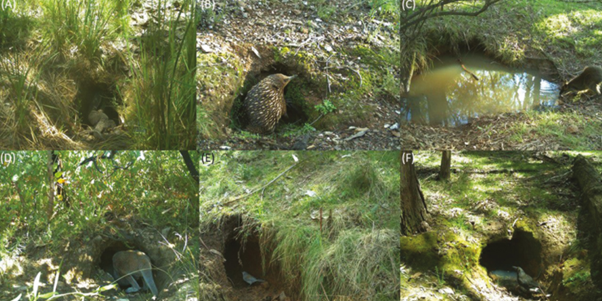In 2019-20, at the height of Australia’s most devastating bushfires, a claim that wombats were herding other animals to safety in their burrows went viral on social media. Sadly, it was too good to be true. Nevertheless, evidence quickly emerged that while wombats were not displaying the altruism of the post, their burrows were used by other species to avoid the heat of the fires. Moreover, when thirsty wombats dug for groundwater, other animals sometimes gained access as well.
New research reveals wombat burrows play an important role even after the emergency has passed. In 2021 zoologists placed 56 cameras in Australian forests to observe activity around burrows of the common wombat (Vombatus ursinus) and at similar, but burrowless, sites both in areas that were burned and in those that were not.
The researchers report that many small species are drawn to the burrows. This included birds like the Painted Button-quail, reptiles like the Lace Monitor, and mammals like the famously horny Agile Antechinus. Even echidnas, remarkable burrowers themselves, were spotted checking out burrows, perhaps for some architectural tips. However, not everyone loves the burrows; some species were found to avoid them.
The researchers concluded the burrows were favored by small creatures that are under threat from predators, even though one might think concentrating at such a location might draw the attention of those they fear. In contrast, the animals that stayed away from the burrows were mostly larger ones with diets similar to wombats, like wallabies and feral pigs – apparently, it’s hard to compete with all that charisma and those mighty butts. Overall, however, areas around burrows are richer in native mammal species, revealing wombats’ importance to the ecosystem.
Moreover, the researchers confirmed what they had suspected: in areas that had burned during the 2019-20 bushfires, some, but not all, species became more associated with wombat burrows. The most extreme example was the Agile Antechinus, which appeared to depend heavily on the burrows in burned areas. If you want a world that includes a mammal that literally shags itself to the point where males are extinct each winter, protecting wombat burrows may prove necessary.

A sample of animals using wombat burrows (A) a Lace Monitor; (B) a Short-beaked Echidna; (C) a Swamp Wallaby drinking from a burrow full of water; (D) a Red-necked Wallaby; (E) a Grey Shrike-thrush foraging; and (F) a Pied Currawong drinking from a partially filled burrow.
Image Credit: Linley et al/ Journal of Mammalogy
Ecosystem engineers increase the richness of life around the world, as can be seen from the multiple benefits of restoring beaver populations. Beaver dam-building is unique, while wombats are not Australia’s only burrowing animals, so their importance might seem less. However, Australia is a very old continent, where most nutrients have been washed to the sea without being restored through recent volcanic activity. That makes life harder and increases the importance of those who overturn the soil, known as bioturbators, of which wombats are Australia’s largest.
Burrow diggers have been found to attract many smaller species to their homes on other continents, so the researchers were not surprised at how popular the wombat burrows were.
Wombats also enrich the nitrogen content of the area around their burrows through their (cubic) droppings. Burrows also sometimes trapped water after heavy rains, and stored it longer than many surface ponds, attracting even quite large animals such as the Eastern Grey Kangaroo.
The authors of the study note that “Given that the frequency of large, severe wildfires is predicted to increase as a result of climatic change, fire refuges created by ecosystem engineers could play a particularly critical role in the future.” Unfortunately, climate change is expected to shrink the range over which the common wombat can comfortably live.
Africa may have its waterholes where the animals of the savannah congregate, but in a flammable future, Australia will depend on wombat burrows for species to meet.
The study is open access in the Journal of Mammalogy.
Source Link: Welcome To Hotel Wombat: Burrows Provide Shelter For Many Small Animals In Need